| Pages:
1
..
5
6
7
8
9
..
13 |
MineMan
International Hazard
    
Posts: 1004
Registered: 29-3-2015
Member Is Offline
Mood: No Mood
|
|
Yah many interests. You kind of high jacked this thread I would recommend posting about the binders else where. I don’t except out of all of the
ones available there must be one that is doable.
|
|
|
mysteriusbhoice
Hazard to Others
  
Posts: 477
Registered: 27-1-2016
Member Is Offline
Mood: Became chemistry catboy Vtuber Nyaa
|
|
I have an alternative way of making copper perchlorate and it hinges on the fact that both copper chloride and sodium perchlorate are both highly
soluble in ethanol but sodium chloride is not.
I will soon make a video on this.
Btw on preparing copper perchlorate with membranes you must use KClO4 and heat the cell below 80C and above 50C because it would otherwise be very
difficult to seperate copper perchlorate from sodium perchlorate
|
|
|
Laboratory of Liptakov
International Hazard
    
Posts: 1396
Registered: 2-9-2014
Location: Technion Haifa
Member Is Offline
Mood: old jew
|
|
Great message, thanks... ...I have both compound for attempt. ...I have both compound for attempt.
I am curious.
[Edited on 5-5-2022 by Laboratory of Liptakov]
Development of primarily - secondary substances CHP (2015) Lithex (2022) Brightelite (2023) Nitrocelite and KC primer (2024)
|
|
|
mysteriusbhoice
Hazard to Others
  
Posts: 477
Registered: 27-1-2016
Member Is Offline
Mood: Became chemistry catboy Vtuber Nyaa
|
|
sadly as for trying to mix CuCl2 and NaClO4 in ethanol and it forms a complex which is deep green in color and doesnt crash NaCl out probably
Na2Cu(ClO4)4 and I used anhydrous ethanol and 99% pure NaClO4 from solvent extraction.
I have also prepared before calcium perchlorate from ethanol, calcium chloride and sodium perchlorate. This can then be reacted with copper sulfate to
form calcium sulfate and copper perchlorate.
I wonder if LL8 can work with somewhat purified Cu(ClO4)2 with slight contamination of NaClO4.
If we are talking about slightly contaminated Cu(ClO4)2 then the most incosequential one would be starting with NH4ClO4 in the membrane electrolysis
stage as the electrolyte.
the membrane electrolysis with heated KClO4 is probably the only thing left to try.
[Edited on 5-5-2022 by mysteriusbhoice]
|
|
|
Laboratory of Liptakov
International Hazard
    
Posts: 1396
Registered: 2-9-2014
Location: Technion Haifa
Member Is Offline
Mood: old jew
|
|
Yes, for example 5% NaClO4 in Cu(ClO4)2 will works sure. (+ hexamine) Neutral Cu(ClO4)2 is problem. Always were problems with acidity in him. (from
HClO4 prepared) Preparation neutral Cu(ClO4)2 from NaClO4 + somethig, require exact verifycated method. Not found yet. Exact weights, temperatures,
times etc.
Development of primarily - secondary substances CHP (2015) Lithex (2022) Brightelite (2023) Nitrocelite and KC primer (2024)
|
|
|
MineMan
International Hazard
    
Posts: 1004
Registered: 29-3-2015
Member Is Offline
Mood: No Mood
|
|
LL, any update on increased density? I can give you a mix with large density that will DDT, you already played around with it. It’s very similar to
dragons tail. Basically if you do dragons tail and the ratios I suggested a few years ago and add two catalyst it DDTs  at the density of a paste at the density of a paste
|
|
|
mysteriusbhoice
Hazard to Others
  
Posts: 477
Registered: 27-1-2016
Member Is Offline
Mood: Became chemistry catboy Vtuber Nyaa
|
|
Quote: Originally posted by Laboratory of Liptakov  | | Yes, for example 5% NaClO4 in Cu(ClO4)2 will works sure. (+ hexamine) Neutral Cu(ClO4)2 is problem. Always were problems with acidity in him. (from
HClO4 prepared) Preparation neutral Cu(ClO4)2 from NaClO4 + somethig, require exact verifycated method. Not found yet. Exact weights, temperatures,
times etc. |
I have done a lot of membrane electrolysis runs to produce Cu(ClO4)2 from NaClO4 and copper sacrificial anode.
it is then left to evaporate and ethanol is added just enuf which doesnt dissolved all of the NaClO4 and isolates somewhat pure Cu(ClO4)2 but to get
the weight you have to dry it again..... carefully and find it out with scale.
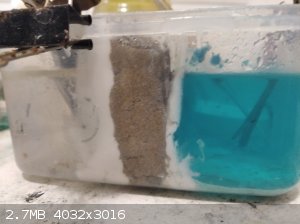
the seperation power totally depends on your membrane and setup an in that pic was the old PVC + Sand but I have made better castable membranes for
easy setup like the ionomer concrete.
mix of sand + OPC cement + CaSO4 9:3:1 ratio.
The CaSO4 can be substituted for cation exchange resin from the water filtration section of any hardware store.
be sure to grind the cation exchange resin in a blender first.
Anion exchange resin is only for anion permeation IE making H2SO4 and other processes.
Overall the thing which happens here is.
Cu + e = Cu2+ (anode)
NaClO4 + Cu2+ = Cu(ClO4)2 + Na+ (anode side)
Na+ + H2O = NaOH + H+ (cathode side)
H+ +e = H2 (cathode)
overall
NaClO4 + Cu + H2O = NaOH + Cu(ClO4)2 + H2
[Edited on 8-5-2022 by mysteriusbhoice]
|
|
|
Laboratory of Liptakov
International Hazard
    
Posts: 1396
Registered: 2-9-2014
Location: Technion Haifa
Member Is Offline
Mood: old jew
|
|
That container looks a little mad. But if it works, it's ingenious equipment. Copper sheets, NaClO4, porous ceramic membrane. After all, we are on a
science madness. Interesting thanks.
[Edited on 7-5-2022 by Laboratory of Liptakov]
Development of primarily - secondary substances CHP (2015) Lithex (2022) Brightelite (2023) Nitrocelite and KC primer (2024)
|
|
|
mysteriusbhoice
Hazard to Others
  
Posts: 477
Registered: 27-1-2016
Member Is Offline
Mood: Became chemistry catboy Vtuber Nyaa
|
|
I have seperated out the copper perchlorate from NaClO4 somewhat from this mix as it does form that green complex but it seems to settle out.
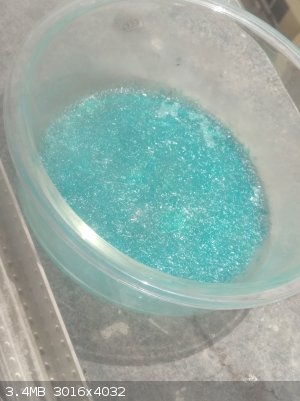
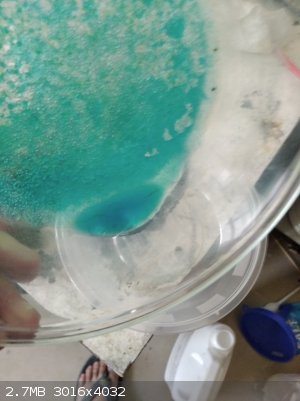
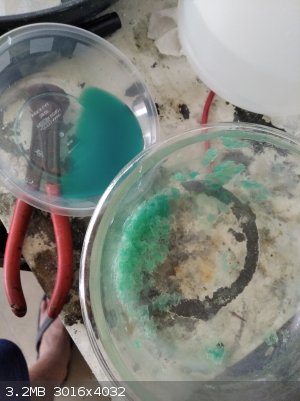
|
|
|
mysteriusbhoice
Hazard to Others
  
Posts: 477
Registered: 27-1-2016
Member Is Offline
Mood: Became chemistry catboy Vtuber Nyaa
|
|
NaClO4 is annoying because its hard to seperate Cu(ClO4)2 from NaClO4 using any solvent.
going ahead and using KClO4 membrane heated to 60C and it seems to be working fine.
hopefully I can create a seperable copper chlorate with less contamination with this.
Using NH4ClO4 is really ideal as NH4ClO4 contamination wont be a big issue.
|
|
|
Laboratory of Liptakov
International Hazard
    
Posts: 1396
Registered: 2-9-2014
Location: Technion Haifa
Member Is Offline
Mood: old jew
|
|
Interesting. Relatively pure neutral Cu(ClO4)2 is not some easy.
Development of primarily - secondary substances CHP (2015) Lithex (2022) Brightelite (2023) Nitrocelite and KC primer (2024)
|
|
|
mysteriusbhoice
Hazard to Others
  
Posts: 477
Registered: 27-1-2016
Member Is Offline
Mood: Became chemistry catboy Vtuber Nyaa
|
|
if you think that is annoying I also get orange copper 1 perchlorate!! :*((( if I let it run for too long.
This weird bright orange precipitate eventually appears coating the anode and settles out and its odd because its energetic!! when mixed with fuel
after washing then dry.
edit: after looking at other images of copper 1 oxide, it may perhaps just be that mixed with some perchlorate residue but IDK honestly will have to
isolate some of it in the future.
The same happens when making copper chloride where white copper 1 chloride is also made somewhere further along the electrolysis.
This bright orange precipitate looks different from copper 1 oxide which is a more dark brown.
I will keep messing about with membranes to try to get the KClO4 Cu(ClO4)2 mix which I believe I had success with this one since KClO4 settles out in
the freezer and is not soluble as much in ethanol or water if its cold.
Problem is I killed my membrane because I decided to run some PbO2 to oxidize copper 1 perchlorates and oxides and yea I let that run too long and
perchloric acid fucked up my polymer membrane since the substrate is polyurea cleaning cloth and not fiberglass which explains the ammonia smell in
the cathode chamber XD.
I am making an ionomer concrete membrane which hopefully will be better.
[Edited on 9-5-2022 by mysteriusbhoice]
|
|
|
ManyInterests
National Hazard
   
Posts: 930
Registered: 19-5-2019
Member Is Offline
|
|
OK... while this is not the CHP thread. I am making good on my promise to start making the stuff for a few CHP synthesis. I spent a month (or almost a
month) to make 500 grams of sodium chlorate (of varying purity) and am now trying to turn that chlorate into perchlorate via heat composition. Just as
LL did in his video.
In the crucible pictured. I added 60 grams of slighly impure sodium chlorate and it has been on my stovetop at the highest heat for almost 3 hours.
The color of the chlorate has become considerably darker, but has not begun to melt or turn into a slurry. I did not wrap anything in aluminium foil.
Am I losing too much heat or what?
EDIT: I took a measurement with a candy thermometer (which broke when I tried to cool it down too fast... goodbye mr. candy thermometer!)
It was well above 200 degrees celsius, which is as far as the thermometer will allow (and it continued to go farther). So I know I am getting good
heat from there. But maybe not as hot as needed?
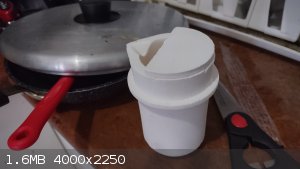
[Edited on 21-6-2022 by ManyInterests]
|
|
|
ManyInterests
National Hazard
   
Posts: 930
Registered: 19-5-2019
Member Is Offline
|
|
So I put it back on the heat with it being wrapped like this. I hope it will be hot enough to turn the chlorate into perchlorate.
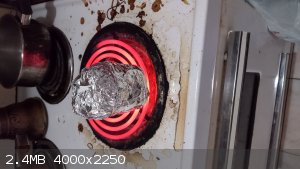
|
|
|
Laboratory of Liptakov
International Hazard
    
Posts: 1396
Registered: 2-9-2014
Location: Technion Haifa
Member Is Offline
Mood: old jew
|
|
Good luck. But the cup on hot wires looks a like really science madness....
[Edited on 22-6-2022 by Laboratory of Liptakov]
Development of primarily - secondary substances CHP (2015) Lithex (2022) Brightelite (2023) Nitrocelite and KC primer (2024)
|
|
|
ManyInterests
National Hazard
   
Posts: 930
Registered: 19-5-2019
Member Is Offline
|
|
OK, so I have tried to make it hotter by putting another larger pot on top of it. The stuff didnt melt, but it did get RED HOT in the crucible. Would
I have some perchlorate there?
Edit: no. I only ended up with 0.2 grams! I need a stronger heat source.
[Edited on 23-6-2022 by ManyInterests]
|
|
|
ManyInterests
National Hazard
   
Posts: 930
Registered: 19-5-2019
Member Is Offline
|
|
I think I am going to have to ask for a bit of advice in making perchlorates. No matter my efforts I cannot make it work through thermal
decomposition.
Edit: Just after a private message talk with LL. I realize that I should have recrystalized and tried to purify my sodium chlorate before commencing
with the heating. While I did order electrodes, I had to order another crucible since my previous one broke. What I will do in the meantime is make
more chlorates and purify my entire supply via methanol crystalization and hopefully try again via the propane torch method.
I will need to make sure everything is pure because even using platinum electrodes requires very pure sodium chlorate to work. So it is a must anyway.
Everything should be ready for the next batch of tests in three weeks or so.
[Edited on 28-6-2022 by ManyInterests]
|
|
|
markx
National Hazard
   
Posts: 646
Registered: 7-8-2003
Location: Northern kingdom
Member Is Offline
Mood: Very Jolly
|
|
Quote: Originally posted by ManyInterests  |
I will need to make sure everything is pure because even using platinum electrodes requires very pure sodium chlorate to work. So it is a must anyway.
Everything should be ready for the next batch of tests in three weeks or so.
[Edited on 28-6-2022 by ManyInterests] |
No you do not strictly need superbly purified chlorate to convert it into perchlorate on platinum anode. In fact I have never engaged in any sort of
purification activities prior to perchlorate conversion....and even worse I routinely go with Pt straight from chloride to perchlorate in the same
cell. Takes a while, but truly the lack of need to babysit and interfere with the process really makes it worth even if the anode lifespan is
compromised. I put chloride into the cell.....fire it on and forget for a month...unless the anode dies before full perchlorate conversion I only have
to add deionised water to top up once in a while. Or saturated chloride solution if I would like to receive "really thick stuff" in the end.
With electrochemical perchlorate production the key element is to be able to have knowledge and possibility to find or make replacement anodes.
Because anything less than a solid brick of Pt is going to be an expendable asset. It will wear out, passivate and disintegrate in a few conversion
runs at best. All the monstrously work and time consuming efforts of starting with "purified and chloride free" feedstock are not really going to make
a noticeable difference in the end. It may make sense to some degree on an industrial scale, but on tabletop reactor realm it is wasted effort.
The "really thick stuff d=1,6g/cm3" not willing to mix with added water on top of it:
https://www.youtube.com/shorts/d7erWvS6JK0
The "expendable Pt anode" resuming work on the perchlorate conversion after being replaced:
https://www.youtube.com/shorts/37r58o5kB_Y
[Edited on 30-6-2022 by markx]
Exact science is a figment of imagination.......
|
|
|
ManyInterests
National Hazard
   
Posts: 930
Registered: 19-5-2019
Member Is Offline
|
|
Glad my information on making chloride straight to perchlorate would work.
Thing is, I've already started my latest and greatest chlorate run. Over 450 grams of chloride in 1350ml of water, plus 9.73 grams of calcium chloride
for pH modification... I also put in 10 grams of magnesium sulfate by accident, but that shouldn't impact the yield. I already see white precipitate
on the bottom of the big jar. It's quite early in the project. But I don't think it'll need more than 10 days to complete.
I am making more chlorates since I was told by someone I am in communication with that I don't have enough chlorates (assuming 100% purity) for a
decent perchlorate run. I just hope to make to one very good sodium perchlorate run, and then convert all I can to ammonium perchlorate.
Then I can make the CHP and the LL8 and lithex that this whole thread was originally about. I did promise LL and Mineman I would make CHP after all.
But I am not going to give up on NHN. I liked making it and I plan on making more of it once I got some nitric acid made.
|
|
|
Theoretic
National Hazard
   
Posts: 776
Registered: 17-6-2003
Location: London, the Land of Sun, Summer and Snow
Member Is Offline
Mood: eating the souls of dust mites
|
|
Quote: Originally posted by mysteriusbhoice  |
I have done a lot of membrane electrolysis runs to produce Cu(ClO4)2 from NaClO4 and copper sacrificial anode.
it is then left to evaporate and ethanol is added just enuf which doesnt dissolved all of the NaClO4 and isolates somewhat pure Cu(ClO4)2 but to get
the weight you have to dry it again..... carefully and find it out with scale.
|
If the compartments are physically separate, perhaps it's unnecessary to let sodium perchlorate be in the copper compartment? If you just put tap
water there, it will provide enough initial conductivity until the perchlorate ions get through the membrane. In the meantime, copper will be turning
into insoluble copper hydroxide until the perchlorate gets there. But that byproduct will be much easier to separate than NaClO4 surely
|
|
|
specialactivitieSK
Hazard to Self
 
Posts: 94
Registered: 21-10-2014
Member Is Offline
Mood: No Mood
|
|
What about extraction LiClO4 from old Li-ion cells.
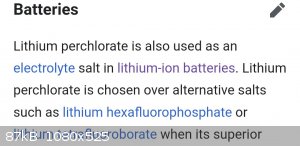
|
|
|
yobbo II
National Hazard
   
Posts: 764
Registered: 28-3-2016
Member Is Offline
Mood: No Mood
|
|
I have seen Li perk. in batteries. It turned methylene blue solution purple.
Could you make Cu perk. from ammonium perk. + cu carbonate.
Dissolve AP then add cu carb. and boil.
The ammonia and CO2 will go away.
Yob
|
|
|
mysteriusbhoice
Hazard to Others
  
Posts: 477
Registered: 27-1-2016
Member Is Offline
Mood: Became chemistry catboy Vtuber Nyaa
|
|
Quote: Originally posted by yobbo II  | I have seen Li perk. in batteries. It turned methylene blue solution purple.
Could you make Cu perk. from ammonium perk. + cu carbonate.
Dissolve AP then add cu carb. and boil.
The ammonia and CO2 will go away.
Yob |
No because at 82C the copper perchlorate decomposes
|
|
|
mysteriusbhoice
Hazard to Others
  
Posts: 477
Registered: 27-1-2016
Member Is Offline
Mood: Became chemistry catboy Vtuber Nyaa
|
|
I just tried adding sodium perchlorate cathodically!! and it works!!
this means you can use Ca(ClO4)2 which is easy to prepare from ethanol!!
this means you can use that to produce very very pure Cu(ClO4)2 with electrolysis because the Ca(OH)2 will not cross the membrane and even fall out of
solution while the mobile perchlorate ions continue.
[Edited on 28-7-2022 by mysteriusbhoice]
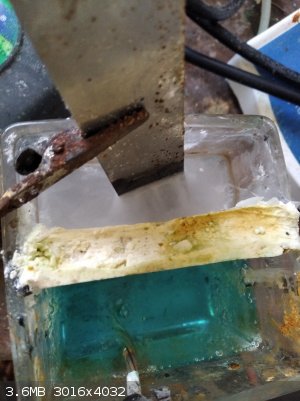
|
|
|
ManyInterests
National Hazard
   
Posts: 930
Registered: 19-5-2019
Member Is Offline
|
|
It looks good there!
I'm working with MysteriusBhoice on making some perchlorates. Hopefully I will make enough to not only make CHP, but also go for some LL8 in the
future as those energetics look very promising.
I have one question on how the caps are loaded. When you use a metal cavity, do you hand press or have a machine press? What are the dangers of
accidental detonation? Is it possible to reach the appropriate density through hand pressing alone? Can they be dead pressed?
|
|
|
| Pages:
1
..
5
6
7
8
9
..
13 |